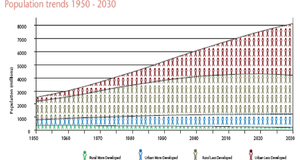Arsenic Contamination of Groundwater in Nepal: Good Public Health Intention Gone BadHistorical Perspective of Environmental IssuesArsenic contamination of groundwater is a global environmental health problem affecting a large number of populations, especially in developing countries. The "Blackfoot disease” that occurred in Taiwan more than half of a century ago was attributed to drinking arsenic-contaminated water from deep wells containing high concentrations of the trivalent arsenite species.25 Similarly, Bangladesh has been historically struggling with environmental and health issues put forth by arsenic contamination of ground water. Similar arsenic poisoning cases were reported later in Chinese Inner Mongolia, Bangladesh, and India—all related to drinking groundwater contaminated with arsenic.26 With the emergence of arsenic poisoning reports in 1998 from Bangladesh and West Bengal (India), there was concern over the possible contamination in Terai groundwater of Nepal because of similarity of geological structures. In 1999, the Department of Water Supply and Sewerage along with other stakeholders in Nepal conducted a comprehensive study of groundwater arsenic contamination in the Terai region.10 Surprisingly, it was found that most of the local tube wells that were used as a primary source of drinking water were contaminated with arsenic beyond maximum contaminated level possessing a serious environmental and health risks to the population. Current Status of the ProblemArsenic contamination of groundwater poses a significant risk to public’s health in the Terai region. High concentration of arsenic (As) in groundwater in the southwestern to southeastern regions of Nepal, located along the Indian border like Sunsari, Saptari, Siraha, Dhanusha, Sarlahi, Rautahat, Bara, Nawalparasi, Rupandehi, Kapilbastu, Banke, Kailali, and Kanchanpur has become a major cause of concern in recent years.27 People living in these districts are still severely affected with groundwater contamination with arsenic, with concentration larger than 50 μg/L. Approximately, 69% of total tube wells have arsenic concentrations <10 ppb, while 31% are above, with 8% >50 ppb and 2.29 million and 0.37 million of population is expected to be drinking water having arsenic concentration 10 - 50 μg/L and >50 μg/L respectively.28 The overall prevalence of arsenicosis symptomatic patients among the risk region is found to be 15.3% with 84.21% melanosis in trunk and 15.79% keratosis in sole and palm.29Despite a number studies and available information, a significant segment of the population residing in the southern borders of Nepal is still exposed to an elevated level of arsenic. An accurate figure of the exposed population may be much higher than presently believed, and requires the majority of the tube wells to be examined. Clinical studies on patients from the arsenic affected districts have displayed symptoms of arsenicosis on the skin as well as other health disorders. Cases of arsenicosis will increase in the future because most of the migration into the Terai region took place after 1970s.20 Agencies Involved and Their ResponsibilitiesRecently, arsenic contamination of groundwater has been recognized as a public health problem in Nepal. The government of Nepal, as wells as NGOs and International Organizations has undertaken a collaborative approach to tackle arsenic related problems. Realizing the severity of arsenic contamination in Terai, Nepal Government has formed a National Arsenic Steering Committee (NASC) in 2001 to coordinate arsenic testing and mitigation program and streamline all activities under a single umbrella.20 The main objectives of the NASC are to coordinate efforts, maintain uniformity, and provide policy-level guidance, develop standards, perform testing, facilitate mitigation and communication with the concerned ministry. The Department of Water Supply and Sewerage (DWSS) of Nepal, in collaboration with UNICEF, trains people involved in water management. They provide training to district engineers, medical personnel, overseers, and technicians involved in water supply and sanitation in the region.10 The Nepal Red Cross Society (NRCS) is one of the leading agencies on water quality testing program at these areas. It has started a project called Drinking Water Quality Improvement Program and Arsenic Mitigation Activities to investigate groundwater As contamination, to identify symptoms of arsenic poisoning and feasible mitigation activities in target areas.30 Environment and Public Health Organization (ENPHO) has promoted arsenic mitigation options, such as Kanchan Arsenic Filter (KAF) in various arsenic affected districts in partnership with DWSS, NRCS, UN-HABITAT, UNICEF and Center for Affordable Water and Sanitation Technology (CAWST). Currently, ENPHO is providing technical support to NRCS to implement Arsenic Mitigation Program in nine highly arsenic affected Terai districts. Several orientations and capacity building trainings on arsenic mitigation options to different groups such as health workers, community motivators, community leaders, school teachers, district technicians, local journalists and entrepreneurs have been conducted.31 Drinking Water Quality Improvement Program (DWQIP) was initiated by NRCS in technical collaboration with ENPHO and Japanese Red Cross Society to improve water quality of affected regions through distribution of household arsenic removal filters, construction of community level arsenic iron removal plants, testing and provision of arsenic safe tube wells, rehabilitation of dug wells and awareness at district and village levels.30 It also established Arsenic Information Center (AIC) that mainly focuses on to provide technical knowledge for the removal of arsenic at the household level, to train local volunteers at district levels and to support all kinds of technical and logistic aspects, such as arsenic and other water quality field-test kits, IEC materials on arsenic, mitigation options, furniture and necessary infrastructure.30 Other national, regional and local agencies, such as Rural Water Supply and Sanitation Project (RWSSSP), the Finnish Government Organization for Developing Countries (FINNIDA), the Rural Water Supply and Sanitation Fund Development Board (RWSSFDB) and Nepal Water for Health (NEWAH) are equally involved in ensuring safe water to people in the region.32 Prevention MeasuresThe incidence of groundwater arsenic contamination is growing in Southern part of Nepal and has possessed a significant public health risk to the people living in the area. Various preventive and mitigation approaches have been put in place in national, regional and local level with the collaboration of multiple stakeholders. The most common measures that can be practiced to prevent or minimize the effect in the region are using alternate sources of drinking water (e.g. pond sand filters, Ranney wells, harvesting rainwater), using different filtration techniques (e.g. filtration, chlorination, UV disinfection, solar radiation, Three Gagri Filters, Arsenic Biosand Filters, using salts of aluminium and iron) and preventing water contamination through development and implementation of efficient waste disposal system. Governments should develop arsenic information and communication strategies to disseminate information and to develop public awareness of the potential dangers of arsenic poisoning and practical mitigation technologies at all levels of society. The institutional capacity to plan, implement, and monitor arsenic mitigation must be strengthened through introduction of formal training programs in schools, and universities. Consistent funding through international donors, governmental as well as non-governmental organizations must be guaranteed to arsenic mitigation plans that is proportional to the degree of human suffering and maintenance of the natural resources base in the affected region. Political Implications and Public Impact on PopulationArsenic contamination of groundwater is directly tied with the country’s already weakening economic position that has been worsening following widespread civil conflict and political unrest. Political instability in Nepal due to its ten-year long civil war has created a dangerous environment with ineffective government institutions and poor economic conditions.33 Large numbers of national and international donors, who were actively supporting the growing scale of safe drinking water projects, withdrew their commitment to fund the projects due to the uneven political situation. All these factors negatively impacted the progress of safe drinking water projects thus increasing the risk of arsenic contamination and its health effects. UNICEF estimates that arsenic contamination could affect more than 1.4 million people across 20 districts in Terai – home to about 47% of Nepal’s population, nearly 90% of whom depend on groundwater for their daily needs.32 The chronic exposure to arsenic imparted characteristic skin manifestations (pigment change), melanosis and keratosis. Some recent studies have reported the prevalence of dermatosis related to arsenicosis from 1.3 to 5.1% and the accumulation of arsenic in biological samples like hair and nail much higher than the acceptable level. Also, chronic arsenic exposure can lead to mental retardation and developmental disabilities such as physical, cognitive, psychological, sensory and speech impairments.34 It has serious implications for its victims (i.e. arsenicosis patients) and their families including social instability, social stigmatization, social discrimination, and marriage-related problems. Children of arsenicosis patients are not allowed to attend social and religious functions as well as denied to take water from a neighbour’s tube well and students debarred from school.34 Though some steps are being taken by government and private organizations to combat the problem, it has not been able to cover all the affected communities. The preliminary investigations in Nepal have shown that the villages situated close to the Indian border in the southern part of Nepal have higher levels of Arsenic contamination.12 Various researches had revealed that the poor, illiterate and farmer are found to be more prone to arsenic contamination. Patients of lower income group are particularly more likely to face economic as well as social problems.29 The highest occurrence is 22.8% in males, 29.09% in illiterate people, 17.50% in the poor, 51.72% in agricultural workers. About half of the arsenicosis patients, particularly female, faced difficulty whilst receiving treatment.35 Long waiting time for receiving treatment, discrimination in service delivery and inadequate separate facility for female patients are major problems.29 In addition, access to health service is particularly difficult for poor patients, as they often had to face problems like unavailability of medicines in the hospitals, travelling long distance, purchasing medicine in most cases etc.36Continued on Next Page » Suggested Reading from Inquiries Journal
Inquiries Journal provides undergraduate and graduate students around the world a platform for the wide dissemination of academic work over a range of core disciplines. Representing the work of students from hundreds of institutions around the globe, Inquiries Journal's large database of academic articles is completely free. Learn more | Blog | Submit Latest in Health Science |


















